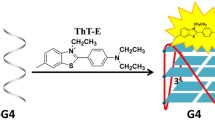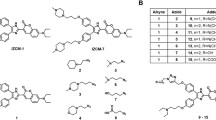Abstract
G4-FID (G-quadruplex fluorescent intercalator displacement) is a simple and fast method that allows to evaluate the affinity of a compound for G-quadruplex DNA and its selectivity towards duplex DNA. This assay is based on the loss of fluorescence of thiazole orange (TO) upon competitive displacement from DNA by a putative ligand. We describe here the development of a high-throughput version of this assay performed in 96-well microplates, and fully transposable to 384-well microplates. The test was calibrated with a set of G-quadruplex ligands characterized for their ability to bind quadruplex within a large range of affinity. The comparison of the results obtained in microplates and in cuvettes was conducted indicating a full agreement. Additionally, the spectral range of the test was enlarged using two other fluorescent on/off probes whose absorption are red-shifted (TO-PRO-3) and blue-shifted (Hoechst 33258) as compared to that of TO. These labels enable to screen a large diversity of compounds with various optical properties, which was exemplified by evaluation of affinity and selectivity of the porphyrin TMPyP4 that could not be evaluated previously. Altogether, our study demonstrates that the HT-G4-FID assay offers the possibility to label a large variety of G-quadruplexes of biological interest and should enable screening of collections of putative G4-ligands of high structural diversity. It thus represents a powerful tool to bring into light new ligands able to discriminate between quadruplexes of different structures.

High-throughput screening and evaluation of quadruplex nucleic acid ligands




Similar content being viewed by others
References
Lipps HJ, Rhodes D (2009) G-quadruplex structures: in vivo evidence and function. Trends Cell Biol 19(8):414–422
Balasubramanian S, Neidle S (2009) G-quadruplex nucleic acids as therapeutic targets. Curr Opin Chem Biol 13(3):345–353
Monchaud D, Teulade-Fichou M-P (2008) A hitchhiker's guide to G-quadruplex ligands. Org Biomol Chem 6(4):627–636
De Cian A, Guittat L, Kaiser M, Sacca B, Amrane S, Bourdoncle A, Alberti P, Teulade-Fichou MP, Lacroix L, Mergny JL (2007) Fluorescence-based melting assays for studying quadruplex ligands. Methods 42(2):183–195
Ragazzon P, Chaires JB (2007) Use of competition dialysis in the discovery of G-quadruplex selective ligands. Methods 43(4):313–323
White EW, Tanious F, Ismail MA, Reszka AP, Neidle S, Boykin DW, Wilson WD (2007) Structure-specific recognition of quadruplex DNA by organic cations: influence of shape, substituents and charge. Biophys Chem 126(1–3):140–153
Rosu F, De Pauw E, Gabelica V (2008) Electrospray mass spectrometry to study drug-nucleic acids interactions. Biochimie 90(7):1074–1087
Rachwal PA, Fox KR (2007) Quadruplex melting. Methods 43(4):291–301
Paramasivan S, Bolton PH (2008) Mix and measure fluorescence screening for selective quadruplex binders. Nucleic Acids Res 36(17):e106
Monchaud D, Allain C, Teulade-Fichou M-P (2006) Development of a fluorescent intercalator displacement assay (G4-FID) for establishing quadruplex-DNA affinity and selectivity of putative ligands. Bioorg Med Chem Lett 16(18):4842–4845
Monchaud D, Allain C, Bertrand H, Smargiasso N, Rosu F, Gabelica V, De Cian A, Mergny JL, Teulade-Fichou MP (2008) Ligands playing musical chairs with G-quadruplex DNA: a rapid and simple displacement assay for identifying selective G-quadruplex binders. Biochimie 90(8):1207–1223
Monchaud D, Teulade-Fichou M-P (2010) G4-FID: a fluorescent DNA probe displacement assay for rapid evaluation of quadruplex ligands. In: Baumann P (ed) G-Quadruplex DNA. Methods in molecular biology, vol 608. Springer, Kansas City, pp 257–271
Burge S, Parkinson GN, Hazel P, Todd AK, Neidle S (2006) Quadruplex DNA: sequence, topology and structure. Nucleic Acids Res 34(19):5402–5415
Dai J, Carver M, Yang D (2008) Polymorphism of human telomeric quadruplex structures. Biochimie 90(8):1172–1183
Kuryavyi V, Phan AT, Patel DJ (2010) Solution structures of all parallel-stranded monomeric and dimeric G-quadruplex scaffolds of the human c-kit2 promoter. Nucleic Acids Res:gkq558
Phan AT, Modi YS, Patel DJ (2004) Propeller-type parallel-stranded G-quadruplexes in the human c-myc promoter. J Am Chem Soc 126(28):8710–8716
Lim KW, Alberti P, Guedin A, Lacroix L, Riou J-F, Royle NJ, Mergny J-L, Phan AT (2009) Sequence variant (CTAGGG)n in the human telomere favors a G-quadruplex structure containing a G-C-G-C tetrad. Nucleic Acids Res 37(18):6239–6248
Wood EJ (1994) Molecular probes: handbook of fluorescent probes and research chemicals: by R P Haugland. pp 390. Interchim. 1992–1994. Biochem Educ 22(2):83
Milanovich N, Suh M, Jankowiak R, Small GJ, Hayes JM (1996) Binding of TO-PRO-3 and TOTO-3 to DNA: fluorescence and hole-burning studies. J Phys Chem 100(21):9181–9186
Sovenyhazy KM, Bordelon JA, Petty JT (2003) Spectroscopic studies of the multiple binding modes of a trimethine-bridged cyanine dye with DNA. Nucleic Acids Res 31(10):2561–2569
Bailly C, Colson P, Henichart J-P, Houssier C (1993) The different binding modes of Hoechst 33258 to DNA studied by electric linear dichroism. Nucleic Acids Res 21(16):3705–3709
Maiti S, Chaudhury NK, Chowdhury S (2003) Hoechst 33258 binds to G-quadruplex in the promoter region of human c-myc. Biochem Biophys Res Commun 310(2):505–512
O'Neill BM, Ratto JE, Good KL, Tahmassebi DC, Helquist SA, Morales JC, Kool ET (2002) A highly effective nonpolar isostere of deoxyguanosine: synthesis, structure, stacking, and base pairing. J Org Chem 67(17):5869–5875
Li G, Huang J, Zhang M, Zhou Y, Zhang D, Wu Z, Wang S, Weng X, Zhou X, Yang G (2008) Bis(benzimidazole)pyridine derivative as a new class of G-quadruplex inducing and stabilizing ligand. Chem Commun (Cambridge, U K) 38:4564–4566
Huang J, Li G, Wu Z, Song Z, Zhou Y, Shuai L, Weng X, Zhou X, Yang G (2009) Bisbenzimidazole to benzobisimidazole: from binding B-form duplex DNA to recognizing different modes of telomereG-quadruplex. Chem Commun (Cambridge, U K) 8:902–904
Jain AK, Reddy VV, Paul AKM, Bhattacharya S (2009) Synthesis and evaluation of a novel class of G-Quadruplex-stabilizing small molecules based on the 1,3-Phenylene-Bis(piperazinyl benzimidazole) system. Biochemistry 48(45):10693–10704
Bhattacharya S, Chaudhuri P, Jain AK, Paul A (2010) Symmetrical bisbenzimidazoles with benzenediyl spacer: the role of the shape of the ligand on the stabilization and structural alterations in telomeric G-Quadruplex DNA and telomerase inhibition. Bioconjug Chem 21(7):1148–1159
Phan AT, Kuryavyi V, Gaw HY, Patel DJ (2005) Small-molecule interaction with a five-guanine-tract G-quadruplex structure from the human MYC promoter. Nat Chem Biol 1(3):167–173
Piazza A, Boule J-B, Lopes J, Mingo K, Largy E, Teulade-Fichou M-P, Nicolas A (2010) Genetic instability triggered by G-quadruplex interacting Phen-DC compounds in Saccharomyces cerevisiae. Nucleic Acids Res 38(13):4337–4348
Teulade-Fichou M-P, Carrasco C, Guittat L, Bailly C, Alberti P, Mergny J-L, David A, Lehn J-M, Wilson WD (2003) Selective recognition of G-quadruplex telomeric DNA by a Bis(quinacridine) macrocycle. J Am Chem Soc 125(16):4732–4740
Murat P, Bonnet R, Van der Heyden A, Spinelli N, Labbé P, Monchaud D, Teulade-Fichou M-P, Dumy P, Defrancq E (2010) Template-assembled synthetic G-quadruplex (TASQ): a useful system for investigating the interactions of ligands with constrained quadruplex topologies. Chem Eur J 16(20):6106–6114
Hounsou C, Guittat L, Monchaud D, Jourdan M, Saettel N, Mergny JL, Teulade-Fichou MP (2007) G-quadruplex recognition by quinacridines: a SAR, NMR, and biological study. ChemMedChem 2(5):655–666
Lemarteleur T, Gomez D, Paterski R, Mandine E, Mailliet P, Riou JF (2004) Stabilization of the c-myc gene promoter quadruplex by specific ligands' inhibitors of telomerase. Biochem Biophys Res Commun 323(3):802–808
De Cian A, DeLemos E, Mergny J-L, Teulade-Fichou M-P, Monchaud D (2007) Highly efficient G-Quadruplex recognition by bisquinolinium compounds. J Am Chem Soc 129(7):1856–1857
Bertrand H, Monchaud D, Cian AD, Guillot R, Mergny J-L, Teulade-Fichou M-P (2007) The importance of metal geometry in the recognition of G-quadruplex-DNA by metal-terpyridine complexes. Org Biomol Chem 5(16):2555–2559
Debray J, Zeghida W, Jourdan M, Monchaud D, Dheu-Andries M-L, Dumy P, Teulade-Fichou M-P, Demeunynck M (2009) Synthesis and evaluation of fused bispyrimidinoacridines as novel pentacyclic analogues of quadruplex-binder BRACO-19. Org Biomol Chem 7(24):5219–5228
De Cian A, Guittat L, Shin-ya K, Riou J-F, Mergny J-L (2005) Affinity and selectivity of G4 ligands measured by FRET. Nucleic Acids Symp Ser 49(1):235–236
Ren J, Chaires JB (1999) Sequence and structural selectivity of nucleic acid binding ligands. Biochemistry 38(49):16067–16075
Acknowledgments
We sincerely thank Marie Perrot and Yoann Lebreton for their technical assistance, Dr. Jean-Louis Mergny and Phong Lan Thao Tran for fruitful discussion, and we gratefully acknowledge the generous financial support from the Centre National de la Recherche Scientifique and the Institut Curie (joint PhD fellowship to E.L.) and the Agence Nationale de la Recherche (ANR) for financial support to F.H. (ANR-09-BLAN-0355 "G4Toolbox").
Author information
Authors and Affiliations
Corresponding author
Electronic supplementary material
Below is the link to the electronic supplementary material.
ESM 1
(PDF 1307 kb)
Rights and permissions
About this article
Cite this article
Largy, E., Hamon, F. & Teulade-Fichou, MP. Development of a high-throughput G4-FID assay for screening and evaluation of small molecules binding quadruplex nucleic acid structures. Anal Bioanal Chem 400, 3419–3427 (2011). https://doi.org/10.1007/s00216-011-5018-z
Received:
Revised:
Accepted:
Published:
Issue Date:
DOI: https://doi.org/10.1007/s00216-011-5018-z




